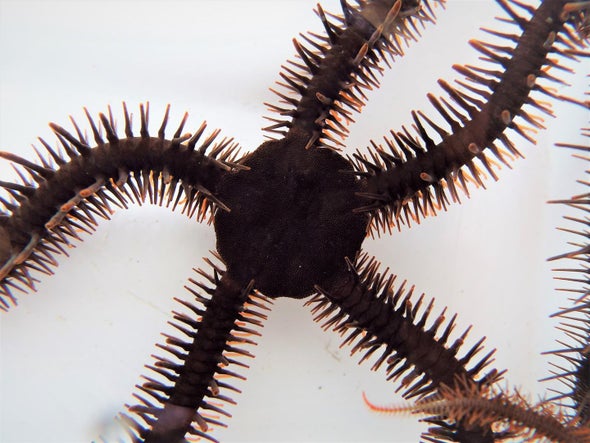(单词翻译:单击)
听力文本
This is Scientific American's 60-second Science, I'm Christopher Intagliata.
Brittle stars are close relatives of starfish with a much more delicate appearance.
"So if you imagine a starfish with really skinny, spiny arms, made up of lots of little articulated plates, that's kind of what a brittle star looks like—a cross between a millipede and a starfish, I guess."
Lauren Sumner-Rooney is a visual ecologist at Oxford University. One of the brittle star species she studies, Ophiocoma wendtii, also has color-changing superpowers.
"If you catch one of these animals during the day, they're a really beautiful reddish brown, dark brown color. If you actually go out again at night and collect the same animal, they're this very pale beige with dark stripes."
The reason for that color shift was murky—perhaps for UV protection or camouflage. But now Sumner-Rooney's team has come up with a possible answer: that red coloration might help the brittle stars sort of see, even though they have no eyes. In bright daylight, their redness filters the light reaching photoreceptors along their arms.
Brittle stars like hiding in shady parts of the reef. So the researchers placed the brittle stars in an environment with black-and-white-patterned walls, aimed at testing whether the creatures were simply light sensitive—which isn't the same as vision—or if they could truly see.

The vision test involved a black vertical bar centered on a white vertical bar twice the width. The nearby walls were 50 percent gray. Without true vision, the black-and-white-patterned area would simply come across as 50 percent gray, and you wouldn't expect the brittle stars to consider that part of the arena a good hiding place.
Instead the brittle stars flocked towards the pattern—suggesting they have at least rudimentary visual skills. But strangely, the creatures lost this ability when they turned from red to beige. After doing digital reconstructions of the visual system, the researchers determined that perhaps the reddish pigments limit the angles of light reaching photoreceptors along the animals' arms—thus improving the resolution of the brittle stars' vision and allowing them to, in their own way, "see."
The results are in the journal Current Biology.
So far, one species of sea urchin has also been shown to have this visual ability without true eyes, and it, too, changes color.
"There could be countless other examples of weird and wonderful visual systems that we have no idea are there—simply because, you know, this animal, looking at it, you can't find 'an eye,' a single discrete visual organ. And there are so many other animals like that that could be using vision, we just haven't looked in the right place yet."
In other words, when it comes to seeing, the eyes don't always have it.
Thanks for listening for Scientific American's 60-second Science. I'm Christopher Intagliata.
参考译文
这里是科学美国人——60秒科学系列,我是克里斯托弗·因塔格里塔。
海蛇尾是海星的近亲,但外表更为精致。
“想象一下海星,它长着细长且多刺、由许多小关节盘组成的腕,这基本上就是海蛇尾的样子,我感觉像是千足虫和海星的杂交体。”
牛津大学的视觉生态学家劳伦·萨姆纳·鲁尼说到。她研究其中一种海蛇尾Ophiocoma wendtii,其还拥有变色超能力。
“如果白天捉到这种海蛇尾,会看到它们呈现出非常漂亮的红棕色和深棕色。如果晚上再去抓,它们就会变成带有深色条纹的浅米色。”
颜色变化的原因尚不明朗,也许是为了防紫外线或伪装。但现在,萨姆纳·鲁尼的团队想出了可能的答案:红色可能会帮助海蛇尾看东西,即使他们没有眼睛。在明亮的日光下,红色会过滤掉沿着腕足到达光感受器的光线。
海蛇尾喜欢藏在礁石的阴暗处。因此,研究人员将海蛇尾放入有黑白图案墙壁的环境中,目的是测试这种生物是否只对光敏感——这与视觉不同——还是它们真的能看见。
视觉测试包括一个置于白色竖条中间的黑色竖条,白竖条的宽度是黑竖条的两倍。附近的墙壁是50度灰色。如果没有真正的视觉,黑白图案区域只会留下50度灰色,你不会指望海蛇尾会将活动场所的这部分看作不错的藏身之处。
相反,海蛇尾会向图案处聚集,这表明它们至少具有最基本的视觉技能。但奇怪的是,当海蛇尾从红色变成米色时,它们就失去了这种能力。对视觉系统进行数字重建后,研究人员确定,也许是光线沿着海蛇尾腕到达光感受器时,红色限制了光的角度,从而提高了海蛇尾的视觉分辨率,并使它们能够以自己的方式“看见”东西。
这项研究发表在《当代生物学》期刊上。
到目前为止,有种海胆也被证明具有这种视觉能力,但它没有眼睛,而且也会变色。
“可能还存在无数我们不知道的奇怪而美妙的视觉系统,仅仅因为这种动物看上去没有眼睛——单一分离的视觉器官。像这样可能具有视觉的动物非常多,我们只是还没有正确的看待它们。”
换言之,就“视力”而言,眼睛并不总是有利。
谢谢大家收听科学美国人——60秒科学。我是克里斯托弗·因塔利亚塔。
译文为可可英语翻译,未经授权请勿转载!
重点讲解
重点讲解:
1. be made up of (由…)构成的;(由…)制成的;
Common salt is made up of 40% sodium and 60% chloride.
食盐由40%的钠和60%的氯化物构成。
2. come up with 想出,提出(计划、想法等);
The president was moved to come up with these suggestions after the hearings.
听证会促使总统想出了这些建议。
3. even though 即使;尽管;纵然;
He's the best teacher, even though he has the least experience.
他虽然经验最少,却是最出色的老师。
4. come across 使产生…印象;给人以…的印象;
When sober he can come across as an extremely pleasant and charming young man.
没喝醉的时候,他看上去似乎是个极为彬彬有礼、讨人喜欢的小伙子。


